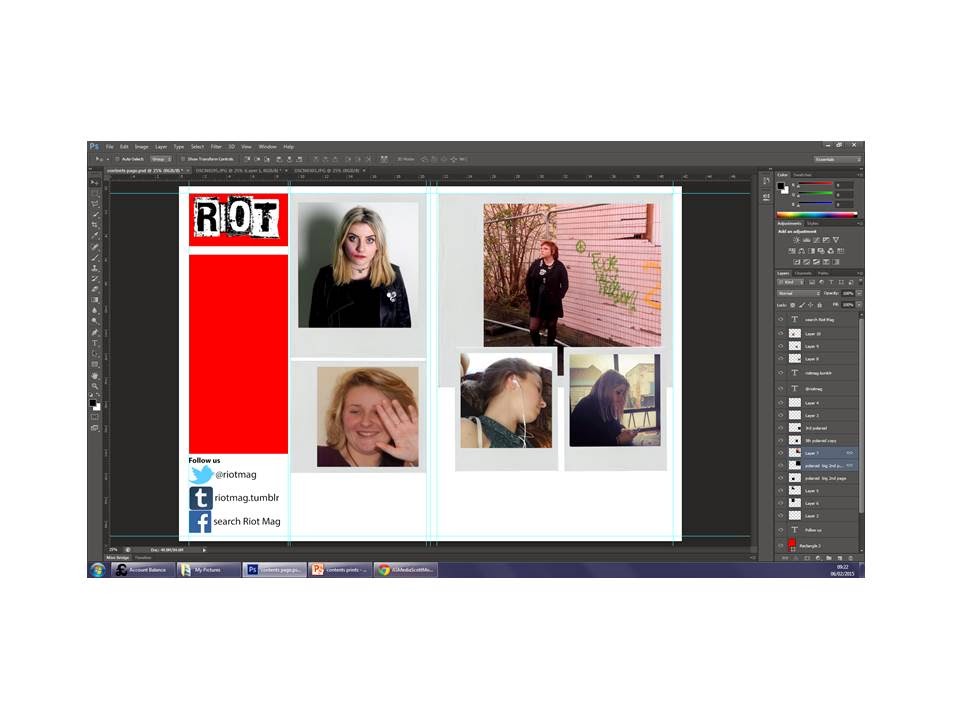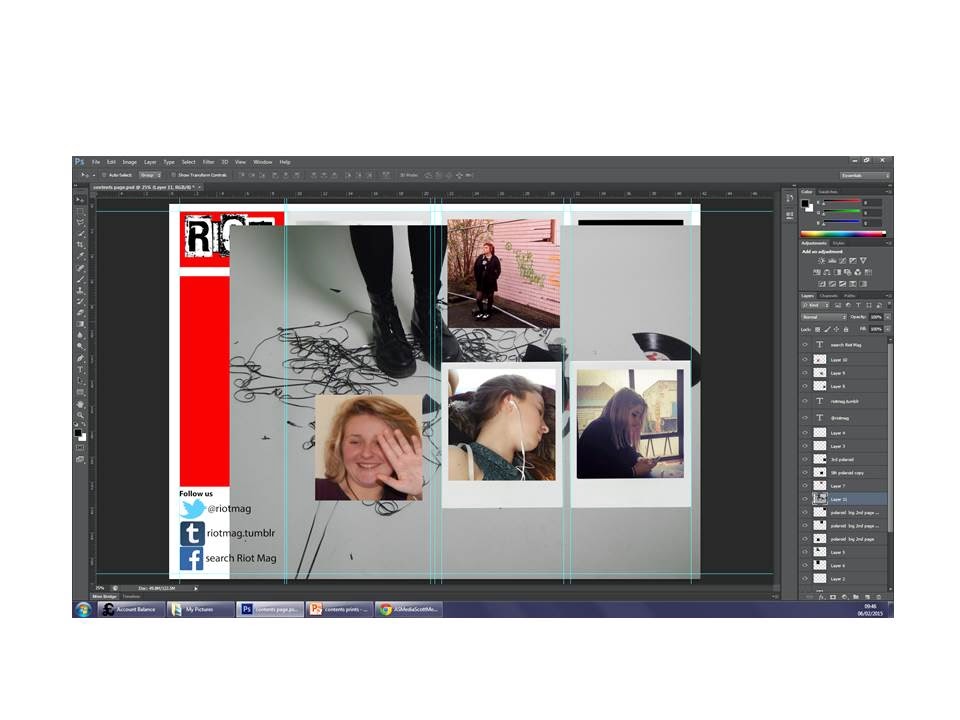Sunday, 19 April 2015
Evaluation Question 1.
In what ways does your media product use, develop or challenge forms and conventions of real media products?
Evaluation Question 6.
What have you learnt about technologies from the process of constructing this product?
My Final Front Cover.
The change I made to the font cover was to replace the 'Mish Hanna' Photoshop text with the text I obtained from Dafont that is iconic of my magazine. This creates cohesion between the masthead and the features.
My Final Contents Page.
I resized, moved and deleted one image.
I first decided to delete one of my images to be able to create more space to put more of an emphasis of my main artist: 'Mish Hanna'. I filled the space created by the loss of an artist by adding a red text box with intentions to use it as space for a 'letter from the editor' which would reflect conventions of music magazines.
I then put text on the polaroid boarders using Photoshop. I used a hand-written font to make it seem like the artists or photographers themselves put captions on the photos which gives it a very personal feel for the audience.
I then copied in my 'letter from the editor' and 'features' that I have saved in Word documents. I put the features in two text boxes since I did not want the text to run over the gate fold.
Final Magazine Double Page Spread.
I began must adjustments by adding page numbers with the 'Riot' masthead accompanying them to create cohesion with the contents page and front cover. I also grouped and moved the image of my artist and the polaroid boarder so that it seen clearer and is not obstructed by the image behind it.
I then made an image of ripped, black paper for a boarder for my article's text. I was not whether I liked it or not. I tried to make ripped, black paper as I thought that it would fit in with the punk aesthetic of my double page spread.
I resized it to make it bigger, so I could fit more of my article of the first page of the feature.
I then used Photoshop to add a white, plain square as another possible background for my text.
Then I had two possible options to use.
I decided to go with the white, plain square as a background and added my text onto it using Publisher. I made all of the questions the interviewer asks red and emboldened whilst making all of the replies from the artist black
Thursday, 5 March 2015
Evaluation.
In what ways does your media product use, develop or challenge forms and conventions of real media products?
In what ways does your media product represent particular social groups?
How does your media product represent particular social groups?
What kind of media institution might distribute your media product and why?
Who will be the audience for your media product?
How did you attract/ address your audience?
What have you learnt about technologies from the process of constructing this product?
In what ways does your media product represent particular social groups?
How does your media product represent particular social groups?
What kind of media institution might distribute your media product and why?
Who will be the audience for your media product?
How did you attract/ address your audience?
What have you learnt about technologies from the process of constructing this product?
Looking back at your preliminary task, what do you feel you have learnt in the progression from it to the full product?
Friday, 13 February 2015
Revised Front Cover.
To improve my front cover; I re-sized the image, moved some of the features, added more features and made the barcode and price smaller.
Double Page Spread and Printscreens.
My double page spread is the beginning of a much larger feature. I used the same typeface for the title as I have done in my contents page and front cover. I also, to create continuity, used a polaroid boarder.
I opened my image and adjusted the levels to make the colours in the image more vivid.
I experimented with the brightness and contrast of the image.
I imported the words that were to create the title of the feature.
I arranged them into order and then found out, roughly, where I wanted them to go.
I then opened the polaroid boarder.
I resized it and cut our the white boarder surrounding the image.
I imported, cropped and then resized an image to go within the boarder. I also changed the levels of the photo.
I grouped and then rotated both the image and the boarder before opening the page in publisher to insert the first part of my article.
Contents Page and Printscreens.
My contents page was inspired by the 'Classic Pop' contents page; I wanted to emulate having large images with the contents running along the bottom. I used one image which to show my main features, which is the same as my front cover and double page spread. I also used an image from my first (and unsuccessful) photoshoot. I placed all my images on polaroid boarders and numbered them to correspond with the contents at the bottom, I also put link to various social media sites. I used the same typography for the magazine name and the 'Contents' as on my front cover to create continuity.
I began by opening my 'Riot' masthead.
Similar to my front cover, I inserted a red rectangle to act as a background for my masthead.
I then, like in the Classic Pop contents page, added another red triangle to act as a background for the word 'Contents'.
I first of all decided that I wanted the page title ('Contents') to come down in a column. However after separating all of the letters and rearranging them, I decided to have the word 'Contents' coming down horizontally.
I opened various logos of social networking sites, like in Classic Pop.
I then inserted text, which showed links to the magazine's pages on social media sites.
I then inserted the image, relating to the main feature which would appear on my double page spread as well as my front cover.
I then cropped it down to fit in a polaroid boarder.
I then inserted a black rectangle to act as a boarder but I did not like this.
I found a better polaroid boarder from the Internet to utilise.
I then spent time copying, organising and re-sizing polaroid boarders.
I began to insert photos into the boarders and experiment with levels, brightness etc in order to give the images a retro camera, polaroid aesthetic.
I inserted more photos and edited them
After experimenting with the layout of the images, I finally got an order that worked.
I decided to swap the image of the boots for another since I wanted that to feature in my double page spread.
I then saved the page as a j-peg file and opened it in publisher to add my text in columns.
Subscribe to:
Comments (Atom)






































































